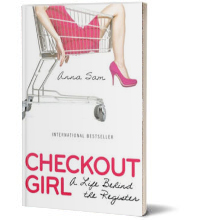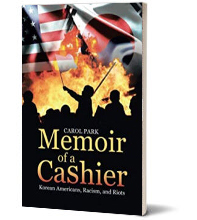Cashier Chronicles
A Book Review of Checkout Girl and Memoir of a Cashier
By Marc H. Guirand, with Becca Braun
Executive Summary: I recommend both books as informative and entertaining ways to learn about life as a cashier. One takes a humorous, lighthearted approach. The other takes a serious and deep approach. Both effectively tell their tales of retail service work and culture.
Checkout Girl: A Life Behind the Register is the English translation of Les Tribulations d’une Caissière, which sold over 250,000 copies in France. In the book, former grocery store cashier Anna Sam offers a glimpse into what takes place behind the register. Having started work at the supermarket in her twenties, after receiving a college degree, Sam comments on everything from ill-cut uniforms and express lane tricks to encounters with drunk and abusive customers. She makes observations that are sometimes hilarious and occasionally hair-raising.

She also highlights dealing with perceived assumptions about the intellect of those in service roles, particularly as a cashier, writing, “People frequently assume that cashiers are less intelligent than professionals. Only high school students, lazy dropouts, and the disenfranchised elderly work the cash register. College graduates are overqualified for jobs in retail. Anyone working as a cashier who is over the age of eighteen must have no work ethic, no education, a drug problem, and/or cognitive deficits.” In fact, Sam recalls a customer encounter where a parent deliberately chastises a child by telling him that if he doesn’t behave, he will end up being a cashier—in other words, there’s no dignity or future in being a cashier.
Then again, Sam does not necessarily hold her customers in the highest esteem. She writes that “working at a supermarket means seeing all sides of humanity. . . You get to see the entire range of human stupidity—and you will be delighted to know that it’s limitless.”
She reminds us what it’s like to deal all day with people who are on their cell phones, writing, “What marvelous inventions. It’s just incredible all the things they can do: play music, show TV, send email, follow the stock market. . . . Some can even make a man (or woman) invisible—and it’s not even the most expensive models that can do it. The fact that cashiers are pretty invisible anyway helps with this trick.”
Further, Sam provides relevant tips and insights on how to survive working at a supermarket. (For instance, readers will become aware of the power of the conveyor belt.)
Lastly, she provides insight into supermarket social dynamics and work culture, dedicating, for example, a chapter to her experiences in the break room, a transient place where she always feels rushed. “The riveting announcements that blast (or sometimes crackle) from the PA system provide some lively entertainment.”
“You get to see the entire range of human stupidity—and you will be delighted to know that it’s limitless.”
Rather than writing a memoir, Sam has compiled and curated a collection of her blog posts. The book’s short chapters give impressionistic snapshots rather than developed ideas, incorporating familiar scenes and common experiences of a dreary job. The result is that it is an easy and lighthearted read as well as somewhat predictable. Additionally, as much as I laughed throughout the book, I also felt uncomfortable. Why? Because I reflected on what my mother might have experienced during her years as a cashier. I am Haitian-American and an immigrant, and my mom worked as a cashier at a ShopRite for years after we moved to the US; two of my siblings also got their first high school jobs as cashiers. Sam’s book offered me a glimpse into that aspect of their lives, and it humbled me, informing me of the difficulties my mom likely had to endure performing in that role—dealing with long hours of repetitive muscle movement and very few restroom breaks. That reminder, in turn, reminded me of the privileges bestowed upon me—going to college and more—by my mother’s work as (among other things) a cashier.
My mom did enjoy some benefit from her experience as a cashier, too. For instance, having to speak with customers complemented her English as a second language night classes and accelerated how quickly she learned English—much more than might have happened in non-customer-facing or back-office type jobs.
It turns out, I found Sam’s book funny enough that I did not dwell on the hardships of her job and, by extension, my mother’s job. I believe Sam’s humorous vignettes will resonate with anyone who has ever been to the supermarket and spent time at a checkout line (i.e., everyone). I highly recommend this book if you need a laugh; need a reminder that you should be grateful to work in a role that gives you flexibility to use the restroom without asking for permission; or you need a reminder to treat retail workers with respect and dignity.
“My mom did enjoy some benefit from her experience as a cashier, too. For instance, having to speak with customers complemented her English as a second language night classes and accelerated how quickly she learned English.”
Another memoir about life as a cashier is the aptly titled Memoir of a Cashier: Korean Americans, Racism, and Riots by Carol Park. In her book, she shares a personal and intimate recollection of her adolescent years in 1980s and 1990s in Los Angeles, a time and place of ethnic strife, drugs, occasional social unrest, and violence. When Park’s mother inherits a Compton gas station from Park’s father, who passes away from smoking-related lung issues, the immigrant widow is left with two teenage boys and a girl (the author) as helpers. In the bulk of her book, Park writes about her long days and nights working at her mom’s gas station. She details her Korean-American experience growing up in the L.A. metro area home to the largest concentration of Korean Americans in the U.S. With candor, she recounts the racism and traumatic incidents she lives through and how her experience as a cashier shapes her perspective around race and ethnic dynamics in America.

Park starts working at the gas station before reaching her teenage years and vividly highlights her premature exposure to violence and verbal abuse from customers who hold a decidedly negative view about the presence of Korean businesses in Black and Latino communities. Black customers continually harass her, and the Rodney King verdict in 1992 brings racial tensions to a peak, exposing her family to the looting instigated by those riots. Over the years, the litany of remarks of angry customers and encounters with violence induce anxiety and occasional sleep issues. Further, her experience in the distressed area surrounding the gas station fosters within her a bitterness toward other races.
Park deliberately highlights how at phases in her life she feels racist and says racist things, even though they are out of frustration and in retaliation to the racism that she herself experiences as a cashier. I believe it takes character to admit such faults and to learn and grow from them, and I applaud her journey from a naïve girl to young adult, aware of the complex social dynamics at play on the corners around the gas station.
Park generally seems to have an employee-employer relationship with her mom, the two of them working and rotating shifts endlessly. “Go work!” her mom repeatedly commands when Park occasionally complains. Park also acknowledges that her sacrifices and experiences as Korean-American girl aren’t particularly unique to her but rather a shared experience across most Korean-American households— Koreans must honor their family and remain wary of sharing personal and family matters with outsiders. She recalls the summer of 1995, right before her sophomore year high-school and how much more she has to work with her mom. “One of the employees quit, and we picked up the Monday through Friday, 2 pm ‒ 10 pm shift. We still worked the weekends from 6 am Saturday morning to Sunday night at 10 pm.”
Beyond the brutal hours, Park experiences several life-altering events—a home robbery, at gunpoint, by someone who she assumes is part of the Chinese mafia. She also has a very unfortunate car-related accident that could have been deadly, but, having survived the riots, the home robbery, and the traumatic injury, Park emerges with a clearer perspective and renewed appreciation for her life. I also enjoyed reading the short section on her first trip to Korea and her experience meeting her maternal family for the first time.
I take from the book the realization that trauma and tragedy can be catalysts for self-realization and growth. While I have experienced my own set of challenges as a Black immigrant in the U.S., reading this book has reinforced my gratitude for my experience growing up in Stamford, Connecticut. I, too, have witnessed violence as a public housing and projects tenant in the U.S., but still—the direct exposure to the many risks that Park experienced makes me feel like I was sheltered. What’s more, her recollections gave me a view into L.A. that I have only otherwise had through movies like Boyz n the Hood and Menace II Society. I also take from the book the fact that no matter the race or ethnicity, a single-parent household can put a huge strain on an entire nuclear family’s relationships.
I have long known that the relationship between Black people and Korean-Americans in LA can at times and in places be troubled, but I had only ever heard that the attitude of Korean-American merchants towards Black people is what causes the trouble. I had never previously considered the abuse Koreans may have also suffered in the communities they serve; Park’s perspective offers me a new viewpoint.
“I, too, have witnessed violence as a public housing and projects tenant in the U.S., but still—the direct exposure to the many risks that Park experienced makes me feel like I was sheltered. What’s more, her recollections gave me a view into L.A. that I have only otherwise had through movies like Boyz n the Hood and Menace II Society.”
Occasional typos in the book and some redundancy might derail some readers’ interests, but typos aside, I found the book highly relevant to the current social context. Anti-Asian sentiment has developed or resurrected itself in recent years and months, unfortunately, and I believe the solution to the huge societal problem lies in dialogue among social groups, and empathy. I’m confident we can address these social issues as a country, but it will take time, as the issues are deeply rooted in oppressive institutions and policies that need to be reformed.
As for a comparison of the two books… in Checkout Girl, Sam occasionally feels invisible, which resonates, because everyone wants to be seen and to feel seen. I empathize with her difficulties navigating adulthood, a tough employment market, and societal norms and perceptions with respect to her type of employment. Nonetheless, I found more value in Park’s narrative and experience working at the gas station as an obligatory service to her mom and family. Whereas Sam’s book, laudable as it is, seems a bit opportunistic—a way to exercise her literary interests—Park’s memoir seems to me to be strategic, telling a deep-seated story of sacrifice and resilience.
The author, Marc Guirand, is a tech entrepreneur in the San Francisco Bay Area and a Braun Ink growth advisor. He wrote this review for us, and Becca Braun contributed significant content editing.
- Story & Biography Expertise